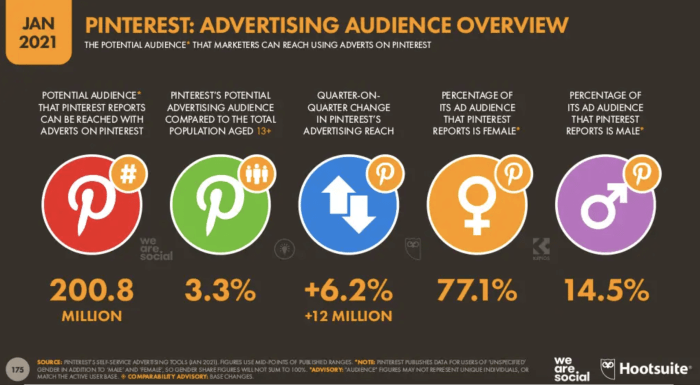Kicking off with Using Pinterest for Business, this opening paragraph is designed to captivate and engage the readers, setting the tone american high school hip style that unfolds with each word.
Pinterest isn’t just for DIY projects and recipes anymore. Businesses are tapping into the visual power of this platform to showcase their products and reach a wider audience. So, grab your virtual pinboard and let’s dive into how to leverage Pinterest for your business success.
Introduction to Using Pinterest for Business

Using Pinterest for business purposes involves leveraging the platform’s visual nature to showcase products, services, and brand aesthetics to a wide audience. It allows businesses to connect with consumers in a creative and engaging way.
Examples of Industries Benefitting from Pinterest
- Fashion and retail: Companies can showcase their latest collections, styling tips, and product details through visually appealing pins.
- Food and beverage: Restaurants, cafes, and food brands can share recipes, food photography, and cooking tutorials to attract food enthusiasts.
- Home decor and interior design: Businesses in this industry can use Pinterest to display home inspiration, DIY projects, and design trends to potential customers.
Advantages of Using Pinterest as a Marketing Tool
- Increased brand visibility: By creating engaging content, businesses can reach a larger audience and increase brand awareness.
- Driving website traffic: Pinterest allows users to link directly to a business’s website, driving traffic and potential sales.
- Engagement with target audience: Businesses can interact with their target audience through comments, likes, and shares, fostering a sense of community.
Setting Up a Business Account on Pinterest

Creating a business account on Pinterest is essential for maximizing your brand’s visibility and engagement on the platform. Follow these steps to set up your Pinterest business account and optimize it for success.
Step 1: Sign Up or Convert
To get started, you can either sign up for a new business account on Pinterest or convert your existing personal account into a business account. Converting allows you to retain your followers and boards while accessing additional features for business use.
Step 2: Complete Your Profile
Fill out all the necessary information in your Pinterest business profile, including a clear profile picture, a concise bio that highlights your brand’s unique selling points, and a link to your website. Make sure your profile is consistent with your brand identity to build trust with your audience.
Step 3: Create Boards and Pins
Organize your content into relevant boards that showcase your products, services, and brand values. Create visually appealing pins that link back to your website or landing pages to drive traffic and conversions. Use high-quality images and engaging descriptions to catch the eye of Pinterest users.
Step 4: Optimize for Search
Utilize s in your board titles, pin descriptions, and profile bio to improve your visibility in Pinterest search results. Incorporate trending hashtags and s related to your industry to attract a broader audience and increase engagement.
Step 5: Analyze Performance
Monitor the performance of your pins and boards using Pinterest Analytics to track metrics such as impressions, clicks, and saves. Use this data to refine your content strategy, identify popular trends, and optimize your Pinterest marketing efforts for better results.
Importance of Branding and Visual Consistency
Branding plays a crucial role in establishing your business identity on Pinterest. Consistent visuals, colors, and messaging across your boards and pins help reinforce brand recognition and build a loyal following. Make sure to use your logo, brand colors, and tone of voice consistently to create a cohesive brand experience for your audience.
Creating Engaging Pins for Business
When it comes to using Pinterest for business, creating engaging pins is crucial to capturing the attention of your audience and driving traffic to your website. A high-quality pin on Pinterest is visually appealing, informative, and relevant to your target audience. It should stand out from the rest and spark curiosity or interest in the viewer.
Characteristics of a High-Quality Pin on Pinterest
- Eye-catching visuals: Use high-quality images that are clear, colorful, and attention-grabbing.
- Informative content: Include a brief and compelling description that provides value to the viewer.
- Branding elements: Incorporate your logo or brand colors to increase brand recognition.
- Call-to-action: Encourage engagement by including a call-to-action that prompts users to click, save, or visit your website.
Designing Visually Appealing Pins, Using Pinterest for Business
- Use templates: Utilize Pinterest’s design tools or third-party apps to create visually cohesive pins.
- Experiment with fonts and colors: Choose fonts and colors that align with your brand and are easy to read.
- Include text overlays: Add text overlays to your images to provide context or highlight key information.
- Optimize for mobile: Ensure your pins are mobile-friendly and easy to view on smaller screens.
Creating Content that Resonates with the Target Audience
- Understand your audience: Research your target demographic to create content that appeals to their interests and needs.
- Stay relevant: Keep up with current trends and topics to ensure your pins remain engaging and timely.
- Showcase your products or services: Highlight the benefits of your offerings in a visually appealing way to attract potential customers.
- Engage with your audience: Respond to comments, messages, and feedback to build a loyal following and drive engagement.
Utilizing Pinterest Analytics: Using Pinterest For Business
When it comes to maximizing your presence on Pinterest as a business, understanding and utilizing Pinterest Analytics is key. This tool provides valuable insights into your audience’s behavior and helps you tailor your marketing strategies accordingly.
Accessing and Interpreting Analytics Data
To access Pinterest Analytics for your business account, simply log in to your account and click on the Analytics tab. Here, you’ll find information on metrics such as impressions, saves, clicks, and more. Interpreting this data allows you to see which pins are performing well and which ones may need improvement.
Significance of Tracking Metrics
- Impressions: By tracking impressions, you can see how many times your pins have been seen by users. This metric helps you gauge the reach of your content.
- Saves: The number of saves indicates how many users have bookmarked your pins for future reference. This shows the relevance and appeal of your content.
- Clicks: Tracking clicks tells you how many users have engaged with your pins by clicking through to your website. This metric measures the effectiveness of your call-to-action.
Leveraging Pinterest Analytics for Marketing Strategies
- Identifying Top Performing Pins: Use analytics to identify which pins are resonating with your audience the most. Replicate the elements that make these pins successful in future content.
- Optimizing Content Strategy: Analyze the data to understand what type of content performs well and tailor your strategy accordingly. This could involve focusing on certain topics, visuals, or formats.
- Testing and Iterating: Experiment with different approaches based on analytics data and track the results. Continuously refine your marketing strategies to maximize engagement and conversions.





